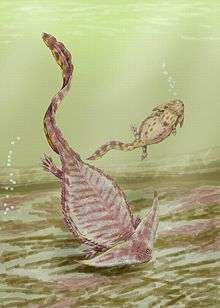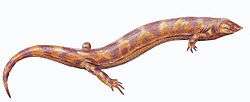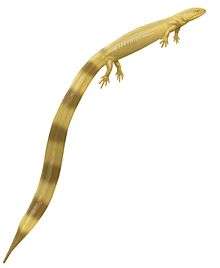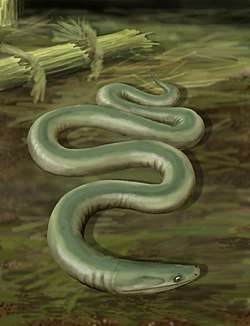Diplocaulus
| Diplocaulus | |
|---|---|
 | |
| Skeleton and model of Diplocaulus magnicornus | |
| Scientific classification | |
| Kingdom: | Animalia |
| Phylum: | Chordata |
| Subclass: | †Lepospondyli |
| Order: | †Nectridea |
| Family: | †Diplocaulidae |
| Genus: | †Diplocaulus Cope, 1877 |
| Species | |
| |
| Synonyms | |
|
Genus-level:
Species-level:
| |
Diplocaulus (meaning "double caul") is an extinct genus of lepospondyl amphibians which lived from the Late Carboniferous to Permian periods of North America and Africa. Diplocaulus are by far the largest and most well-known lepospondyls, characterized by a distinctive boomerang-shaped skull. Remains attributed to Diplocaulus have been found from the Late Permian of Morocco and represent the youngest known occurrence of a lepospondyl.
Description
Diplocaulus had a stocky, salamander-like body, but was relatively large, reaching up to 1 m (3.3 ft) in length. Although a complete tail is unknown for the genus, a nearly complete articulated skeleton described in 1917 preserved a row of tail vertebrae near the head. This was construed as circumstantial evidence for a long, thin tail capable of reaching the head if the animal was curled up.[1] Most studies since this discovery have argued that anguiliform (eel-like) tail movement was the main force of locomotion utilized by Diplocaulus and its relatives.[2][3] The most distinctive features of this genus and its closest relatives were the long protrusions known as tabular horns on the sides of its skull, giving the head a boomerang shape.[3]
Species
D. salamandroides
D. salamandroides was the first species of Diplocaulus to be discovered. Remains from this species were discovered near Danville, Illinois by William Gurley and J.C. Winslow, a pair of local geologists. The fossils were later described by renowned paleontologist Edward Drinker Cope in 1877. This species is only known from a small number of vertebrae sent to Cope by Gurley and Winslow. These vertebrae were noted for their similarities to those of salamanders (hence the specific name salamandroides), although Cope was reluctant to refer them to any known group. A large jaw bone with labyrinthodont teeth was associated with some of these vertebrae, but it was much larger than expected for the vertebrae and likely belonged to Eryops or some other larger amphibian.[4] D. salamandroides could be distinguished from D. magnicornis by its small size (from a fifth to a sixth the size of the latter) and less pronounced accessory articular processes (at the time identified as zygosphene-zygantrum articulations).[5]
The rocks in which these fossils were discovered had been informally referred to as the "Clepsydrops shales", named after a local genus of early synapsid by Cope in 1865. The shales were initially believed to be from either the Permian or Triassic periods in age based on the purported presence of reptile and lungfish fossils. By 1878, Cope had decided that the site was Permian. In 1908, E.C. Case noted that the shales also contain remains from fish which were from the late Carboniferous and early Permian periods. He argued that, while the Clepsydrops shales of Illinois and the similar red beds of Texas were evidently formed after the major Carboniferous coal deposits, there was not sufficient evidence to exclude them from the Carboniferous period itself. [6] Nowadays the Clepsydrops shales are typically assigned to the McLeansboro or Mattoon Formations. D. salamandroides fossils have also been found in Pennsylvania. These formations are now believed to be Missourian (late Carboniferous) in age.[7]
D. magnicornis
This species, described by Cope in 1882, is by far the most common and well-described member of the genus. D. magnicornis was the first species known from more than vertebrae, and it allowed Cope and other paleontologists to realize the nature of Diplocaulus as a bizarre long-horned "batrachian" (amphibian).[8] Much of modern knowledge on the genus is based on this species, as it outnumbers any other Diplocaulus remains by hundreds of specimens. D. magnicornis had a wide temporal distribution throughout the red beds of Texas and Oklahoma.
D. brevirostris
D. brevirostris was similar to D. magnicornis, although it was significantly more rare. It is represented by a small number of specimens found in an early strata of the Texas red beds, specifically the Arroyo Formation of the Clear Fork Group. This species can be differentiated from D. magnicornis by the much shorter and blunter snout compared to the length of the skull as a whole. In addition, the horns are more elongated, the parietals have a convex upper surface, and the rear edge of the skull is more strongly and smoothly curved. While juvenile members of D. magnicornis also have a smoothly curved rear edge of the skull, all known D. brevirostris specimens are clearly adults as shown by their robust skull ornamentation, long horns, and large size. Therefore, this trait is a legitimate distinguishing feature of adult specimens of this species. The only specimen known from more than a skull is the type specimen, AM 4470, which preserves some vertebrae similar to those of "D. primigenius". E.C. Olson, the original describer of the species, suggested that it occupied different habitats than D. magnicornis such as mountain streams, accounting for its comparative rarity.[9] However, other studies have suggested that D. magnicornis would have lived in similar environments, invalidating Olson's hypothesis.[3]
D. recurvatus
This species, from the Vale Formation of the Texas red beds, was very similar to D. magnicornis, and partially coexisted alongside that species in younger strata. Olson hypothesized that D. recurvatus may have been descended from an early stock of D. magnicornis.[10] D. recurvatus differs from D. magnicornis in one specific trait: the tips of the tabular horns are "crooked". The tips are bent relative to the rest of the horns, and abruptly taper.[11] Comparison to a growth series of D. magnicornis indicates that D. recurvatus specimens had developmental pathways which significantly differed from D. magnicornis. For example, skull length and width seem to be inversely correlated in D. recurvatus and directly correlated in D. magnicornis.[10] In addition, the restriction in the horns of D. recurvatus develops in an area which would otherwise expand in adult D. magnicornis.[12]
D. minimus
Diplocaulus minimus is a species known from the Ikakern Formation of Morocco. It had an unusually asymmetrical skull, with the left prong being long and tapering as in other species but the right prong being much shorter and more rounded. This feature was present in multiple skulls referred to this species, so it is very unlikely to be a result of crushing or distortion. Some studies have suggested that this species is more closely related to Diploceraspis than to Diplocaulus magnicornus. This may suggest that Diplocaulus is not a true monophyletic genus, Diploceraspis is a junior synonym of the genus, or that "Diplocaulus" minimus represents a distinct genus.[13]
Dubious species
- D. limbatus was the third species of Diplocaulus to be named, and remained the second most well known member of the genus until the 1950s. It was described by E.D. Cope in 1895 based on several incomplete specimens found in the Texas red beds. The type specimen was a poorly preserved skull and partial skeleton designated AM 4471. Cope found that the skull of this specimen had shorter, thinner horns than those of D. magnicornis, as well as a seemingly unique feature: a large notch separating the quadratojugal from the rest of the tabular horn.[14] E.C. Case later provided additional distinctions present in a skull referred to D. limbatus, including smoother edges to the skull, larger eyes, and more pointed horns.[15] However, additional D. limbatus specimens prepared by Douthitt have shown that many of Case's identifications were erroneous, and that only the notch identified by Cope could be used to distinguish it from D. magnicornis.[1] In 1951, E.C. Olson concluded that AM 4471 was too poorly preserved to differentiate from D. magnicornis, and therefore he designated D. limbatus as a synonym of that species. However, he also analyzed the referred D. limbatus skull described by Case, AM 4470, and found that it was unique enough to qualify as the type specimen of a new Diplocaulus species: D. brevirostris.[9]
Paleoecology
A trio of three juvenile Diplocaulus in a burrow of eight (plus one juvenile Eryops) were found to have been partially eaten by the sail-backed synapsid Dimetrodon, which likely unearthed the amphibians during a drought. One of the three was killed with a bite to the head, taking part of its skull and portions of the brain, a fatal injury that the animal could not defend against.[16]
Function of the tabular horns
Various hypotheses have been put forth to the purpose of these horns. One of the earliest suggestions, provided by S.W. Williston in 1909, was that they protected external gills,[17] but in 1911 E.C. Case pointed out that there was slim evidence for this idea.[15] Another hypothesis was provided in a dissertation, published by Illinois biologist Herman Douthitt in 1917, which focused entirely on the anatomy of Diplocaulus. Douthitt argued that the most undisputed function was that the horns acted as a counterweight to offset the heavily-built forward part of the head which would have been difficult to lift otherwise. However, he also noted that this was probably not their primary function, and that they may have been maladaptive developments "as the result of some internal metabolic derangement".[1]
In 1951, E.C. Olson suggested that the horns could have supported skin flaps capable of assisting the animal in skate- or stingray-like locomotion. However, he admitted that his suggestion was entirely conjectural considering a lack of soft tissue evidence. He also briefly proposed other possible functions, such as the use of the broad head as a burrowing tool to escape predators or survive droughts.[9] J.R. Beerbower revived the hypothesis that the horns were involved in respiration during his 1963 description of Diploceraspis, which was a close relative of Diplocaulus. His argument relied on the possibility that the horns supported operculum-like vertical pouches protecting external or internal gills.[2]
One possibility is that the shape was defensive, since even a large predator would have a hard time trying to swallow a creature with such a wide head.[18]
Diplocaulus on display
- The fossilized skeleton of a Diplocaulus is on display at the University of Michigan Museum of Natural History in Ann Arbor. The display presents art of the Diplocaulus with the controversial skin extending from the tips of the head to the tail.
- The fossilized skeleton of a Diplocaulus is on display at the Houston Museum of Natural Science in Houston.
Gallery
- Skull of Diplocaulus magnicornis at the Berlin's Natural History Museum
 Life reconstruction of Diplocaulus, by Dimitri Bogdanov
Life reconstruction of Diplocaulus, by Dimitri Bogdanov Life reconstruction of Diplocaulus, by Dimitri Bogdanov
Life reconstruction of Diplocaulus, by Dimitri Bogdanov Life reconstruction of Diplocaulus with mimetic dorsal skin[19]
Life reconstruction of Diplocaulus with mimetic dorsal skin[19]
References
| Wikimedia Commons has media related to Diplocaulus. |
- 1 2 3 Douthitt, Herman (September 1917). "The Structure and Relationships of Diplocaulus". Contributions from Walker Museum. 2 (1): 1–42.
- 1 2 Beerbower, J.R. (November 1963). "Morphology, paleoecology, and phylogeny of the Permo-Pennsylvania amphibian Diploceraspis". Bulletin of the Museum of Comparitive Zoology. 130 (2): 31–108.
- 1 2 3 Cruickshank, A. R. I.; Skews, B. W. (1980). "The Functional Significance of Nectridean Tabular Horns (Amphibia: Lepospondyli)". Proceedings of the Royal Society B: Biological Sciences. 209 (1177): 513–537. doi:10.1098/rspb.1980.0110.
- ↑ Cope, E.D. (2 November 1877). "Descriptions of Extinct Vertebrata from the Permian and Triassic Formations of the United States". Proceedings of the American Philosophical Society. 17 (1): 182–193.
- ↑ Case, E.C. (1900). "Contributions from Walker Museum. I: The Vertebrates from the Permian Bone Bed of Vermilion County, Illinois". The Journal of Geology. 8 (8): 698–729. doi:10.1086/620866.
- ↑ Case, E.C. (1908). "On the Value of the Evidence Furnished by Vertebrate Fossils of Age of Certain So-Called Permian Beds in America". The Journal of Geology. 16 (6): 572–580.
- ↑ Harris, Susan K.; Lucas, Spencer G.; Berman, David S.; Henrici, Amy C. (2005). "Diplocaulus cranial material from the lower Abo Formation (Wolfcampian) of New Mexico and the stratigraphic distribution of the genus" (PDF). New Mexico Museum of Natural History and Science Bulletin. 30: 101–103.
- ↑ Cope, E.D. (15 September 1882). "Third Contribution to the History of the Vertebrata of the Permian Formation of Texas". Proceedings of the American Philosophical Society. 20 (112): 447–461.
- 1 2 3 Olson, E.C. (12 January 1951). "Diplocaulus: A study in growth and variation". Fieldiana: Geology. 11 (2): 59–149.
- 1 2 Olson, Everret C. (November 1953). "Integrating Factors in Amphibian Skulls". The Journal of Geology. 61 (6): 557–568. doi:10.1086/626128.
- ↑ Olson, E.C. (27 June 1952). "Fauna of the upper Vale and Choza: 6, Diplocaulus". Fieldiana: Geology. 10 (14): 147–166.
- ↑ Olson, Everett C. (September 1972). "Diplocaulus parvus n. sp. (Amphibia: Nectridea) from the Chickasha Formation (Permian: Guadalupian) of Oklahoma". Journal of Paleontology. 46 (5): 656–659.
- ↑ Germain, Damien (27 May 2010). "The Moroccan diplocaulid: the last lepospondyl, the single one on Gondwana". Historical Biology. 22: 4–39.
- ↑ Cope, E.D. (15 November 1895). "Some New Batrachia from the Permian of Texas". Proceedings of the American Philosophical Society. 34: 452–457.
- 1 2 Case, E.C. (1911). "Revision of the Amphibia and Pisces of the Permian of North America". Carnegie Institution of Washington publication. 146: 15–91.
- ↑ Zoehfeld, Weidner K.; Bakker, Robert T.; Flis, Chris J.; Pettersson, Carl B.; Bell, Troy H. (2013). "Abstract: BURROWS AND BREAK-INS ON THE TEXAS PERMIAN DELTA: STACKED AESTIVATING AMPHIBIANS AND ATTACKS BY DIMETRODON (2013 GSA Annual Meeting in Denver: 125th Anniversary of GSA (27-30 October 2013))". gsa.confex.com.
- ↑ Williston, S.W. (1909). "The Skull and Extremities of Diplocaulus". Transactions of the Kansas Academy of Science. 22: 122–132.
- ↑ Palmer, D., ed. (1999). The Marshall Illustrated Encyclopedia of Dinosaurs and Prehistoric Animals. London: Marshall Editions. p. 55. ISBN 1-84028-152-9.
- ↑ Cf.



